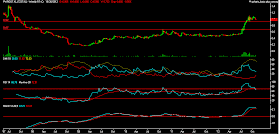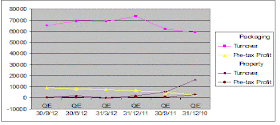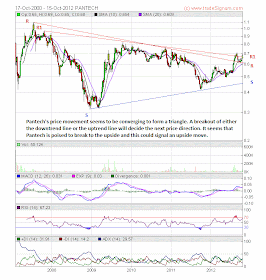With interest rate on FDs at 3%, many savers are forced to invest their saving somewhere in order to hedge against inflation. In an effort to elevate their return, investors are tempted to take a leap of faith into the unknown & 'invest' based on tips in the stock market. Today, we saw one stock, Linear de-listed from our exchange and another, SAAG suffered a sharp drop as it was classified under PN1. I have written about these two stocks in 2010 & 2011 (
here &
here). Their fall is a sad reminder that we have to be very careful investing in penny stocks.
 Chart 1: SAAG's weekly chart as at Oct 15, 2012_12.30pm (Source: quickcharts)
Chart 1: SAAG's weekly chart as at Oct 15, 2012_12.30pm (Source: quickcharts)
 Chart 2: Linear's weekly chart as at Oct 12, 2012 (Source: quickcharts)
Chart 2: Linear's weekly chart as at Oct 12, 2012 (Source: quickcharts)
To avoid the madness of the market, some investors have gotten themselves into a bigger trouble by investing in gold trading schemes. That is not the only investment traps out there. This morning, I received an email from a reader asking about two oil palm schemes, Country Height Growers Scheme (CHGS) & Golden Palm Growers Berhad (GPGB). Some of the information was made available by a weblog named
Palm Oil The Cash Crop. The schemes pay an annual income from Year 1 after your investment. For RM100k investment, the CHGS scheme pays an annual income of RM8k for year 1-3 and RM12k for Year 4-23. For a similar investment, the GPGB scheme pays an annual income of RM6k for Year 1-6; a gradually rising annual income of RM15k-21k for Year 7-17; and a gradually declining annual income of RM20-15k for Year 18-20.
My reply to him is as follows:
1. Any investment scheme where there is an income stream before the
business can generate income should be treated with caution. This is how
CHGS or GPGB are structured. The purpose of this structure is to induce
people to buy into the schemes. This can lead to a ponzi effect where
more money is collected and the sponsor is tempted to flee with the
money. If you choose to be generous & kind to the sponsor, you may
argue that the sponsor is a listed company & they won't do such
thing. I am not sure.
2. This is an unlisted vehicle where if
you want to liquidate, you have to abide by terms & conditions laid
down by the management company. To me, this is more than a hassle. It is
a serious setback that is seldom appreciated
by investors who value the false security of an investment that is not
subject to the vagaries of the market more than the restriction set by
the management company.
3. If you can overcome the mental block
described in (2) above, then you will see that there is a vehicle in
Bursa that is almost the same as CHGS or GPGB. That vehicle is called
BSDReit, which gives a 6% yield. You may say CHGS or GPGB gives a better
return, which may or may not be true.
Notwithstanding the above,
you have to ask yourself - should I get into the oil palm sector? The
words of the Minister seem to be very negative for CPO going forward and
yet many simply regard it as an inconvenience or a short-term setback. I
hope I am wrong & the Minister was exaggerating.
My further thoughts:
Like a bank financing a house buyer, your investment in the oil palm scheme is a long-term financing for a long-term investment. Just as a bank cannot withdraw a housing loan once disbursed, you cannot withdraw from the above scheme once you have participated in it. To withdraw, you need to find a buyer who is willing to buy out your investment. Alternatively, the management company may buyback your investment at a steep discount with a view to reselling it. While this scheme may be genuine investment vehicle, you must consider your investment time horizon. If you need the fund within the next 3-5 years, you should avoid investing in the oil palm scheme because the payback time is 20 years.
It is important to note that
I didn't say that CHGS or GPGB are ponzi schemes. The truth is I am not sure what they are. However, both schemes have one feature that is common in many Ponzi Schemes - the payment of income to the investors which is likely to come from the capital contributed by subsequent investors. One would come to this conclusion by asking a simple question: where would the business (of the oil palm estate) get the money to pay the income to the investors during the first three years of operation when it has not generated any income?
One way to work around this is to argue that the income actually come from investor's initial capital. For example, when you invest RM100k
in this scheme, a certain percentage (RM24k in the case of CHGS or
RM18k in the case of GPGB) would be set aside to pay your income for
the first 3 years. If you are prepared to accept this explanation, then you have to agree that the sales pitch includes at least one misrepresentation (by omission) which is the income for the first three years is actually from the investor's capital. This explanation will only be offered at the last resort because investors who had invested in this scheme would look pretty stupid when they are told that their income is simply from their own capital.
Whatever is their modus operandi, I hope that oil palm scheme will be self-sustaining despite my misgivings. It is not impossible that the scheme can be self-sustaining (if the estates are well-run & the 'bleeding' is confined to the 3-year of income payment). Nevertheless, I do not believe the return will be as exciting as promised. My main concern is that the scheme will be so successful that the sponsors or management companies would be deluged with cash to the point that they would be tempted to abscond with the money. I hope that the sponsors or management companies have set up trusts to hold the funds as well as to regulate the receipt & disbursement of the funds. Trustee arrangement has worked very well in the unit trusts industry and it can work even in other investment scheme, such as the oil palm scheme.
Finally, if you are a busy person with loads of work & a hectic family life, I would advise you to invest in unit trust. Split your investment between an equity fund (try AMB Dividend Trust or Kenanga Growth) and a bond fund (try AmDynamic Bond & KAF Bond). You may also want to put 20% in property trusts and 10% in precious metals. A good place to get your unit trusts at a very low cost is Fund Supermart (
here). Whatever you decide, be sure to consider the return of your investment as much as the return on your investment.





















































